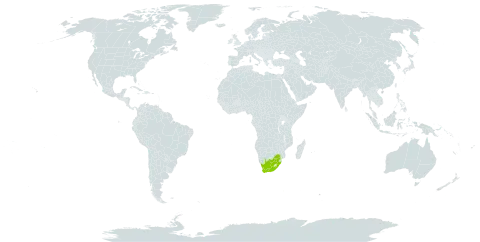Plant an acaulescent rosette, (20-)25-100(-140) mm diam., usually solitary, at or below soil-level. Roots stout, up to 90 mm long, 15 mm thick, napiform, whitish-tan. Leaves ca. 7-15, tightly clustered, ascending, sharply truncate to convex at the tips, rarely grooved or obliquely concave, very firm, to 45 mm long, 25 mm broad, 20 mm thick at the base of the windowed area, turning reddish when old. Upper leaf surface schizoid: convex and +/-rectangular toward the base, dark blackish-green to bluish-green, rarely deep brownish-red, unmarked, opaque, smooth, hidden from view except when turgid, +/-truncate and deltoid above, ca. 10-15 mm long x 10-l5 mm wide, dark green to bluish-green or slate-blue, rarely dark brown, often flushed with purple, strongly and darkly windowed, not spotted but always marked with whitish venations, veins 2-3(-5), narrow, often smudged, usually parallel toward the leaf base, often reticulate toward the tips, reaching the outer margins in bowed patterns, varying greatly amongst the leaves of a single plant (and over time); epidermis finely and evenly crystalline (or scabrid), translucent, with a slight sheen. Margins delicately ciliate, leaf tips with a short whitish apiculus ca. 1 mm long. Lower surface of leaves dark green to blackish, very finely granulate, completely unmarked and opaque, often with a slight central keel, strongly bulging when turgid. Flowers vernal (August-September in habitat, March-April in northern captivity), scentless. Peduncle simple, terete, ca 2.5 mm thick, very variable in length, to 30 cm long. Raceme bearing up to 50 buds and flowers, buds not tightly clustered, usually 3-5 open simultaneously, with one or two new flowers per day (opening ca. 10 A.M.), each lasting 4-5 days. Sterile bracts 10-20, the lowest ca. 10 mm from the base. Pedicels 2 mm long, 0.8 mm thick, terete, pale brownish-green, ± erect, shielded by the fertile bracts, those 3 mm long, 2 mm broad, deltoid, laciniate, pale whitish-green, almost hyaline, with a dark green central nerve. Perianth creamy white, to16 mm long, at the base 3 mm across, narrowing to 1.5 mm above, erect, ± curved; upper petals obtuse, white with a broad to very broad green nerve; lower petals to 10 mm long, obtuse, strongly recurved. Stamens 6, filaments 4 mm long, 0.5 mm thick, pale green, anthers 1 mm long, bright yellow. Gynoecium cucumber-shaped, 4 mm long, 2 mm diam., bright green, style 1 mm long, curved, pure white. Fruits 15 mm long x 3 mm diam., smooth, sulcate, dull green when unripe, greyish and brittle when ripe, impersistent. Seeds dull dark grey, to 2.0 x 1.6 x 0.8 mm, irregularly angled.
More
Solitary, acaulescent succulent. Leaves abruptly recurved, dark green, translucent along veins, often scabrid. Flowers white.
